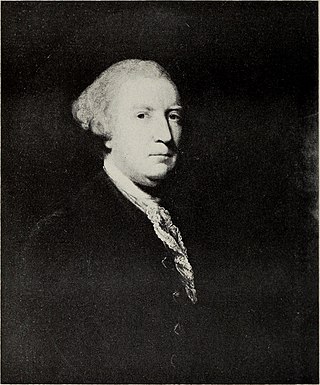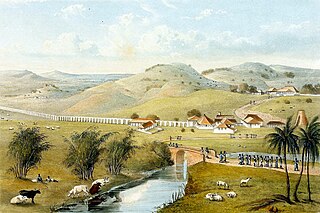Related Research Articles

Sir William Beckford was a Jamaican-born planter and Whig politician who twice served as Lord Mayor of London in 1762 and 1769. One of the best known political figures in Georgian era London, his vast wealth derived from the sugar plantations and hundreds of slaves he owned in the British colony of Jamaica. In Britain, Beckford was a supporter of the Whig party, including Prime Minister William Pitt, 1st Earl of Chatham. He also publicly supported progressive causes and frequently championed the London public.

Sir Henry Moore, 1st Baronet was a Jamaican-born colonial administrator who served as the governor of New York from 1765 to 1769, when he died in office. Moore also served as the lieutenant governor of Jamaica in 1756 and again from 1759 to 1762. He was granted a baronetcy in 1764.

The Baptist War, also known as the Sam Sharp Rebellion, the Christmas Rebellion, the Christmas Uprising and the Great Jamaican Slave Revolt of 1831–32, was an eleven-day rebellion that started on 25 December 1831 and involved up to 60,000 of the 300,000 slaves in the Colony of Jamaica. The uprising was led by a black Baptist deacon, Samuel Sharpe, and waged largely by his followers. The revolt, though militarily unsuccessful, played a major part in the abolition of slavery throughout the British Empire.

Accompong is a historical Maroon village located in the hills of St. Elizabeth Parish on the island of Jamaica. It is located in Cockpit Country, where Jamaican Maroons and indigenous Taíno established a fortified stronghold in the hilly terrain in the 17th century. They defended it and maintained independence from the Spanish and then later the British, after the colony changed hands.

Westmoreland is the westernmost parish in Jamaica, located on the south side of the island. It is situated south of Hanover, southwest of Saint James, and northwest of Saint Elizabeth, in the county of Cornwall. The chief town and capital is Savanna-la-Mar. Negril, a famous tourist destination, is also situated in the parish.
Edward Long was a British-born planter, historian and writer best known for writing a book about the history of Jamaica in 1774 that was heavily rooted in proslavery thought.

Tacky's Revolt was a slave rebellion in the British colony of Jamaica which lasted from 7 April 1760 to 1761. Spearheaded by self-emancipated Coromantee people, the rebels were led by a Fante royal named Tacky. It was the most significant slave rebellion in the West Indies between the 1733 slave insurrection on St. John and the 1791 Haitian Revolution. The rebels were eventually defeated after British colonial forces, assisted by Jamaican Maroons, waged a gruelling counterinsurgency campaign. According to historian Trevor Burnard, "[in] terms of its shock to the imperial system, only the American Revolution surpassed Tacky's War in the eighteenth century." It was also the largest slave rebellion in the British West Indies until the Baptist War of 1831, which also occurred in Jamaica.
Jamaican Maroons descend from Africans who freed themselves from slavery in the Colony of Jamaica and established communities of free black people in the island's mountainous interior, primarily in the eastern parishes. Africans who were enslaved during Spanish rule over Jamaica (1493–1655) may have been the first to develop such refugee communities.
Vincent Brown is Charles Warren Professor of History, Professor of African and African-American Studies, and Director of the History Design Studio at Harvard University. His research, writing, teaching, and other creative endeavors are focused on the political dimensions of cultural practice in the African Diaspora, with a particular emphasis on the early modern Atlantic world.

Arthur Forrest was a Royal Navy officer and planter who saw service during the War of the Austrian Succession and the Seven Years' War, rising to the rank of captain and the post of commodore. He also owned 3,000 acres of sugar plantations, and a considerable number of slaves, in the Colony of Jamaica.

The Crown Colony of Jamaica and Dependencies was a British colony from 1655, when it was captured by the English Protectorate from the Spanish Empire. Jamaica became a British colony from 1707 and a Crown colony in 1866. The Colony was primarily used for sugarcane production, and experienced many slave rebellions over the course of British rule. Jamaica was granted independence in 1962.
English colonist William Vassall (1592–1656) is remembered both for promoting religious freedom in New England and commencing his family's ownership of slave plantations in the Caribbean. A patentee of the Massachusetts Bay Company, Vassall was among the merchants who petitioned Puritan courts for greater civil liberties and religious tolerance. In 1647, he and John Child published New-England’s Jonas cast up in London, a tract describing the efforts of colonial petitioners. By early 1648, Vassall moved to Barbados to establish a slave-labor sugar plantation. He and his descendants were among the Caribbean's leading planters, holding more than 3,865 people as slaves before Britain abolished slavery in 1833.
Joseph Foster Barham, the younger was an English politician, merchant and plantation owner.

Henry Dawkins II was a Jamaican plantation and slave owner and Member of the Parliament of Great Britain (MP).

Nathaniel Bayly was an English planter and politician who sat in the House of Commons from 1770 to 1779.
Crawford's Town was one of the two main towns belonging to the Windward Maroons, who fought a guerrilla war of resistance against the British colonial forces of Jamaica during the First Maroon War of the 1730s.
The Receiver General of Jamaica was the public official in Jamaica responsible for receiving and disbursing money of the Government of Jamaica.

Trinity was a plantation in colonial Jamaica, located south of Port Maria, in Saint Mary Parish, one of several plantations owned by Zachary Bayly that formed part of the area known as Bayly's Vale. By the early nineteenth century, over 1,000 people were enslaved there producing mainly sugar and rum for which a mile-long aqueduct was built by Nathaniel Bayly to supply water for the refining process.
Free black people in Jamaica fell into two categories. Some secured their freedom officially, and lived within the slave communities of the Colony of Jamaica. Others ran away from slavery, and formed independent communities in the forested mountains of the interior. This latter group included the Jamaican Maroons, and subsequent fugitives from the sugar and coffee plantations of coastal Jamaica.
References
- ↑ Vincent Brown, Tacky's Revolt: The Story of an Atlantic Slave War(Cambridge, Massachusetts: Harvard University Press, 2020), p. 54.
- 1 2 "The Letters of Simon Taylor of Jamaica to Chaloner Arcedekne, 1765-1775" edited by Betty Wood et al in Betty Wood & Martin Lynn (Eds.) (2002). Travel, Trade and Power in the Atlantic 1765-1884. Camden Fifth Series Vol. 19. Miscellany XXXV. Cambridge: Cambridge University Press. pp. 1–164 (p. 16). ISBN 978-0-521-82312-8.
- ↑ Zachary Bayly. Legacies of British Slave-ownership, UCL. Retrieved 14 May 2019.
- ↑ Vincent Brown, Tacky's Revolt: The Story of an Atlantic Slave War(Cambridge, Massachusetts: Harvard University Press, 2020), p. 53.
- ↑ Vincent Brown, Tacky's Revolt: The Story of an Atlantic Slave War(Cambridge, Massachusetts: Harvard University Press, 2020), p. 54.
- ↑ Zachary Bayly. Legacies of British Slave-ownership, UCL. Retrieved 14 May 2019.
- ↑ Vincent Brown, Tacky's Revolt: The Story of an Atlantic Slave War(Cambridge, Massachusetts: Harvard University Press, 2020), p. 53.